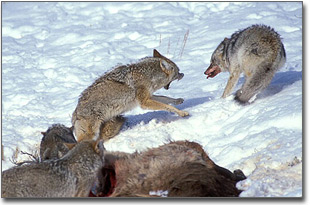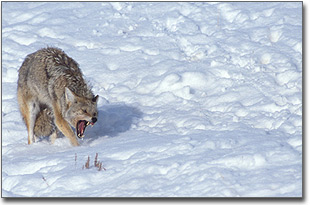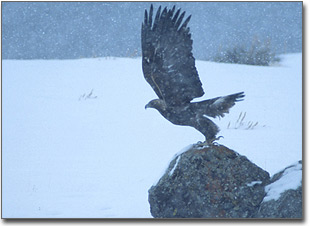|
|

All rights reserved. Lamar Valley, Yellowstone National Park. It was here, in 1994, one of the packs slated to reestablish the wolf as the top predator in the Yellowstone Ecosystem was released. Since then, the success of what became known as the Druid Pack has been phenomenal. They have become the undisputed monarchs of the upper Lamar Valley, and, along with the Rose Creek Pack in the lower Lamar, have redefined the ecology of Yellowstone’s Northern Range. Two years ago they even became movie stars when National Geographic released “Return of the Wolf,“ a film by Bob Landis. It is a spectacular chronicle of wolf behavior in the wild. The sequel has just been completed, and if anything, it is even more impressive. No release date has been set.
But there are spin-off benefits for photographers. The coyote population in the Lamar has been almost halved by the wolves, and those remaining seem to be more prevalent along the road, making a living by mousing or, unfortunately, begging. It is a rare winter trip when the opportunity to photograph coyotes does not occur. The wolves have affected elk movements too. During winters with average or above snow packs (unlike recent ones), herds of cow elk gather in the open valley bottom, and often move in large groups, responding to wolves. Consequently, the possibility of photographing them enmasse occurs quite often. However, the symbiotic relationship between wolves and photographers is most evident when the predators provide bait stations to attract wildlife – in other words, carcasses. In the winter of 2000-2001, the Druid Pack numbered 28 individuals. To provide enough food for that number of mouths, the Druids have become an efficient killing machine. Elk are the preferred prey, and kills are generally made at night. Most often one, but sometimes two elk are taken. On rare occasions, the chase ends near the road, and the wolves are then too wary to feed during the day. When that occurs, the carcass becomes a smorgasbord for scavengers that reside a little farther down the food chain.
A total of six coyotes visited the carcass, most of them more than once. Two were a mated pair, and they were dominant when feeding. Single coyotes would sometimes approach them in that peculiar hunch-backed, crabbing, gaping run that seems a mixture of both subservience and defiance. These single coyotes would be allowed to feed, but were always wary, their eyes furtively on the lookout even as they were tearing meat off the carcass. Often they’d have to quickly dodge the snapping jaws of one of the more dominant pair. At one point the pair went off a short distance and mated. Magpies and ravens were almost constantly on the carcass, and were occasionally annoying enough to the coyotes to elicit a half-hearted lunge. On another occasion, I have a shot of a wolf fully airborne trying to get at a raven over a carcass. But like most wolf photographs, if it were twenty times closer it would be acceptable. I photographed one raven dragging a rib bone across the hard packed snow, trying to secret it from his competitors. All in all, I wouldn’t be surprised if birds actually got most of the meat off the elk; so continual was their feeding. The most exciting subject was the eagle. Golden eagles are usually pretty spooky, but there’s a pair in the upper Lamar that have become reasonably tolerant (for eagles) in recent years. These would perch in nearby trees and on rocks, but didn’t actually come in to feed while I was there. Occasionally they would circle the area, giving me the opportunity for flight shots. Fortunately, a favorite perch was a lichen-encrusted boulder in reasonable range. I waited for the better part of two days, but never did get them on the carcass.
In late winter, weather conditions are always variable in the Lamar Valley, and this weekend was no exception. Snow squalls would blow through creating mini-blizzards, and ten minutes later the whole valley would be in full sun. Getting subjects in heavy, falling snow is always a treat, and I was able to fill some gaps in my coverage of both eagles and coyotes. I’ve got more than one frame showing that I was paying more attention to the action than to the changing exposure, but generally things turned out well. The 600 was still the lens to use, although I was more sparing with the converters. With this amount of interest, plus the initial feeding by the wolves, carcasses don’t last that long. Within a couple days, they’re just scattered bones and hair. Today, there’s no evidence that for a short time the site was a delicatessen, opened by the Druids, and serving cold cuts to all that caught the scent. Note - Since this article was written, there have been changes in the Druid Pack. Due to dispersion of young wolves, and territorial conflicts with adjacent packs, the Druids are now down to eight individuals. There is some speculation as to whether or not they'll be able to hold their dominance in the Lamar Valley. The breeding season is now under way, so we'll hope for the best. Pete & Alice -NPN 085 Comments on NPN wildlife photography articles? Send them to the editor. |
|
|
 Now, each winter, photographers and wolf watchers gather in the Lamar to record and view the spectacle that unfolds before them almost daily. Like beads on a string, small knots of cars collect along the paved road when the wolves are visible. The Lamar valley is mostly sagebrush and grass, and much of the stage that the drama is played out on is easily visible. Like any attempt to photograph wildlife, being there early and late is almost mandatory. Photographers however, should not expect the portraits and frame-filling compositions that are produced at game farms. The wolves are definitely not habituated to humans, and much of the action takes place quite a distance from the road. A 600mm lens is a minimum, and for most of the shots I’ve taken over the years I’ve added a 1.4 or 2X converter. I’ve been lucky enough to shoot both chase and kill sequences, but they’re more interesting than artistic.
Now, each winter, photographers and wolf watchers gather in the Lamar to record and view the spectacle that unfolds before them almost daily. Like beads on a string, small knots of cars collect along the paved road when the wolves are visible. The Lamar valley is mostly sagebrush and grass, and much of the stage that the drama is played out on is easily visible. Like any attempt to photograph wildlife, being there early and late is almost mandatory. Photographers however, should not expect the portraits and frame-filling compositions that are produced at game farms. The wolves are definitely not habituated to humans, and much of the action takes place quite a distance from the road. A 600mm lens is a minimum, and for most of the shots I’ve taken over the years I’ve added a 1.4 or 2X converter. I’ve been lucky enough to shoot both chase and kill sequences, but they’re more interesting than artistic.  This scenario occurred once late last winter, and for two days the opportunity to photograph and observe the interaction among coyotes, ravens, magpies, and golden eagles at close range was unequaled. In the last few years I’ve tried to orient my wildlife photography more toward animal behavior, and carcasses provide a bonanza of interaction. From a photography standpoint, all I had to do was set up and wait for things to happen.
This scenario occurred once late last winter, and for two days the opportunity to photograph and observe the interaction among coyotes, ravens, magpies, and golden eagles at close range was unequaled. In the last few years I’ve tried to orient my wildlife photography more toward animal behavior, and carcasses provide a bonanza of interaction. From a photography standpoint, all I had to do was set up and wait for things to happen.  Like many of us, being a weekend photographer, I’m always at the mercy of work schedules and travel times. On Sunday, I left for home in the middle of the day. That evening, for the last twenty minutes of sunlight, a golden glided in, landed on the carcass, and gorged itself. This work stuff gets to be confining at times.
Like many of us, being a weekend photographer, I’m always at the mercy of work schedules and travel times. On Sunday, I left for home in the middle of the day. That evening, for the last twenty minutes of sunlight, a golden glided in, landed on the carcass, and gorged itself. This work stuff gets to be confining at times.